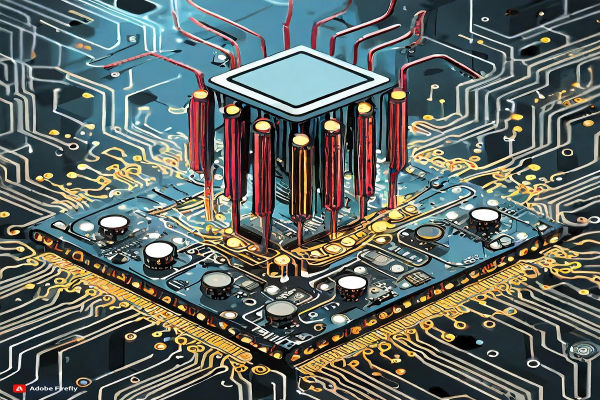Power-grid infrastructure is becoming more reliable and efficient due to advancements in power devices and the power generation industry. At the moment, power electronics handle up to 40% of the electricity produced between generation and final consumption.
High-efficiency designs are essential to data-center architectures as the power consumption of data-center applications increases relative to the overall electrical power consumption.
Power electronics advancements have led to an increase in electric aerospace applications, such as fully electric engines or hydraulic networks that do not need hydraulics.
Up to 80% of global electric power is predicted to depend in some way on power electronics by 2030. Hence, power electronics are becoming essential for enhancing energy efficiency, cutting down on power usage, and making it possible to incorporate renewable energy sources into the electrical grid.
The Modern Era
The creation and broad use of power semiconductor devices has greatly influenced the current era of power electronics. These specialist parts serve as switches or rectifiers in power electronic circuits and are made to withstand high voltages and currents.![]()
The Latest Breakthrough
The most recent development in power electronics uses materials such as gallium nitride (GaN) and silicon carbide (SiC).
When compared to conventional silicon-based devices, these materials operate better at greater voltages, temperatures, and switching frequencies.
GaN technology has the potential to increase the efficiency of renewable energy sources, such as wind farms and solar panels. GaN devices can lower these systems’ overall carbon footprint. To realize their full potential, however, advancements in circuit design and applications are needed.
The Dominance of SiC Transistors
In industrial power electronics, SiC transistors are poised to emerge as a compelling substitute for the well-established IGBT technology of today.
At high blocking voltages, minority carrier free unipolar devices can be designed in place of charge modulated IGBT devices thanks to SiC’s unique material features. This is mostly predicated on the broad bandgap’s provision of a high critical field.
The dynamics of minority carriers are the reason behind the loss limitations of IGBTs. Minority carriers are eliminated in MOSFETs.![]()
Power Electronics in Electric Drivetrains
Power electronics are essential for controlling engines and converting battery current into mechanical energy in electric drivetrains.
Direct current is frequently produced by wind and solar energy in the field of renewable energy, and effective inverters are needed to feed this into the electrical grid.
The same is true for power electronics for battery storage systems, power-grid stability, where power frequency and voltage regulation are important, and how reactive power compensation can strengthen grid stability.
The EV Sector and the SiC Boom
In the EV sector, where SiC presently commands a 38.5% market share, WBG semiconductors have made notable progress.
GaN is becoming more and more popular because it can be used with integrated chargers, allowing for higher switching frequencies and smaller, more energy-efficient devices.
Since the potential to minimize the size of on-board devices might ultimately effect the size of EV batteries, GaN is an appealing alternative for EV power circuits.
Microinverters Complementing WBG Growth
Microinverters are essential for transforming DC power from solar panels into AC power in the context of solar energy. Despite the efficiency and size reduction benefits of SiC, GaN might not be immediately appropriate for high-power solar infrastructure (1.2-, 1.7-, 3.3-, and 5-kV levels). Nevertheless, additional advancements in WBG technology could lead to opportunities in the future of microinverters.![]()
Propelling Power Semiconductor Devices
According to Power Systems Design, the market for power semiconductor devices is expanding quickly, with projections of $41.81 billion in 2023 and $49.23 billion by 2028. The growing need for energy-efficient solutions across a range of industries is fueling this expansion, and as power electronics develop further, the main goals will be to boost power density, increase efficiency, and push the limits of voltage and current handling capabilities.
Potential of Diamond-Based Devices
Currently, a number of wide bandgap materials are being investigated for power conversion, including diamond, gallium oxide (Ga2O3), silicon carbide (SiC), and gallium nitride (GaN). Many people believe that diamond-based devices have the most potential of these, however, they are limited by their small wafer size, scalability problems, and expense.
The increasing use of copper clips as an alternative to more traditional wire and ribbon bonding will result in significant changes in packaging solutions at the electrical interconnections level.
The use of WBG semiconductor die technologies, such as silver sintering die attachment, low-inductance electrical connections, and high-temperature epoxy.
Wide gap device adoption necessitates creative packaging strategies and solutions, yet their influence on the market for packaging materials will be relatively small because the smaller die size in comparison to silicon devices, as well as the still-small share of SiC and GaN technologies.
According to numerous experts, diamond offers the best electronic and physical characteristics for powering modern power electronics components.
Conclusion
The ability of the power electronics industry to adjust to new materials and technologies in order to satisfy the always-increasing demand for effective electronic systems is closely related to its evolution. GaN and SiC will continue to play a key role in this process, advancing power electronics, but one cannot evade the future dominance of Diamond.



